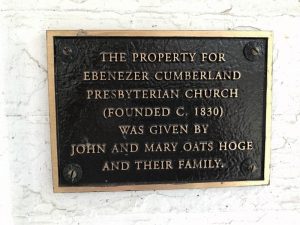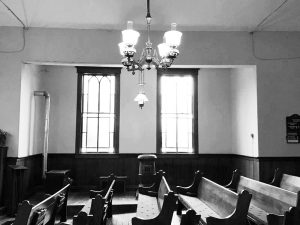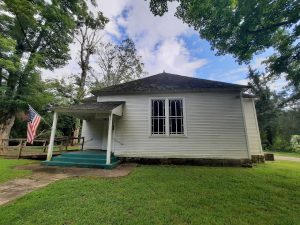
BETH WOMACK JORDAN – contributor
The Ebenezer Cumberland Presbyterian (CP) Church at the intersection of Highway 27 and East Valley Road was designated as a National Register of Historic Places property in 2020. The site around the current church was an old Indian Trading Post and was established as the home of John Hoge, Sr. in 1826. He named the site Evergreen Knoll. Mr. Hoge and his father-in-law, Colonel David Oates, were known to have traded with the local Cherokee Indians at this site in the early 1800’s. The John Hoge, Sr. farm consisted of 364 acres which included the Little Cedar Mountain area.
In 1828, the Hoge House was built at the crossroads of the “Pike” (East Valley Road) and the Old Stagecoach Road (Lock & Dam Road/RA Griffith Highway). The Hoge House still stands on the Evergreen Knoll just past The Ebenezer CP Church today. John and Mary Oats Hoge donated land for the church in 1830. The original church stood on a knoll on the opposite side of the road from the current church. During that time, camp meetings were popular, and a “camp” ground was set up in the field adjoining the current church site. Approximately 100 log cabins were built for people to live in while attending the camp meetings and some would stay for 6 weeks or longer. 
Founders of the church included: Alexander Kelly (1803-1879), Elizabeth Oats Kelly (1802-1871), John Hoge, Sr. (1796-1856), Mary Oats Hoge (1800-1856), George W. Shelton (1812-1880), and Sara Hornbeak Shelton. Elizabeth Oats Kelly and Mary Oats Hoge were daughters of David Oats. Mr. Oats was a prominent entrepreneur and pioneer who owned Oats (sometimes spelled Oates) Landing – a trading post located in the flooded area of Bennett Lake before Hales Bar Dam. He was later noted to be one of the wealthiest citizens of Marion County. On Elizabeth “Betsy” Pack’s deed of 40 acres in 1819 to establish the county seat at Jasper, she listed David Oates and John Hoge in the trust of the land and the “Town Spring” to the county.
Ebenezer Church was likely the first Cumberland Presbyterian church in the Sequatchie Valley and was a charter congregation in the Ocoee Presbytery. The church was destroyed by a Tornado (local papers referred to it as Cyclone or Hurricane) twice – once in 1854 and again 1909. Most all records of the church were destroyed by those tornados. After the destruction of the first building, the second church was erected near the initial site – about 600 yards east of the Hoge House. After the second church was destroyed, the third church was built on the same site in 1914 and included communion table, lamps which had been converted to electric from coal oil and the pot-bellied stove from the original church building. Ebenezer Church used the school as a meeting place until the third church was built.
 From the records that do exist from the earliest times of the church, the first marriage was recorded in January 1846. Reverend Hiram Douglass officiated the wedding of W. J. Kelly and Sarah Ann Hoge. The first recorded baptism was David A. Kelly who was the son of David O. and Lucinda Kelly on May 22nd, 1870. The congregation was noted at 60 members in 1868. In 1856 during a church service, all members had gone down to the altar to pray. After prayer was over, all members began to make their way back to their seats except for Mary Oats Hoge wife of John Hoge, Sr. who had died at the altar in prayer.
From the records that do exist from the earliest times of the church, the first marriage was recorded in January 1846. Reverend Hiram Douglass officiated the wedding of W. J. Kelly and Sarah Ann Hoge. The first recorded baptism was David A. Kelly who was the son of David O. and Lucinda Kelly on May 22nd, 1870. The congregation was noted at 60 members in 1868. In 1856 during a church service, all members had gone down to the altar to pray. After prayer was over, all members began to make their way back to their seats except for Mary Oats Hoge wife of John Hoge, Sr. who had died at the altar in prayer.
Camp meeting attendance declined in the late 1860’s and the cabins were not repaired or replaced. By 1900, all the cabins were gone. Logs from the cabins were used to build an addition to the John Hoge, Sr. house around 1869. Sometime in the late 1870’s, the church transitioned to a “circuit” were one minister served several churches. Ebenezer, Oak Grove, Whitwell and Cedar Springs Cumberland Presbyterian Churches shared one minister and preaching services were rotated to each church. Services at Ebenezer were held on the fourth Saturday and Sunday of each month. These early ministers, although sometimes untrained, were strong supporters of missionary work and camp meetings.
Leading families in the church’s early years include: Shelton, Hornbeck, Kelly, Hoge, Prigmore, Pryor, Oats, Hall, Mitchell, Peck, Turner, Bennett.
Prior to the Civil War some of the leading elders included; Alexander Kelly, George W. Shelton, Philllip H. Ealy and J. B. Kelly. Ministers included Walter McGill, John W. Ritchy, John Moyers, Aaron Grigsby (1840’s then moved to Texas) and Hiram Douglas. In 1865, Revered W.H. Bell was the minister at Ebenezer. After his death in 1876, the church was served by “circuit” ministers. The membership in 1891-92 was 62.
The church was struck by a second tornado in 1909. Margie Gott Vollhim, daughter of Revered Aaron Grigsby, told that after tornado hit the church, the roof was on the ridge and the walls had fell in on itself. Some of the original items were able to be salvaged. The congregation began meeting in the Ebenezer School until a new church could be built. The members worked hard to raise the funds needed for a new church. In the August 1911 Cumberland Presbyterian publication, it stated “this is a splendid people, and they are struggling hard to build a new house of worship as the storm of three years ago razed the old one….The Ladies Aid and Missionary Society has done some commendable work in that they have raised a fund of $150.00 for the new church building. We hope to begin our building at a very early date.” The publication also noted “Sometime during the summer we intend to begin work on our new church. This is a faithful people.”
Finally on the fourth Sunday in May 1914, the new church as it stands today was dedicated. Reverend J. A. Whitener preached the dedication sermon.
Monies raised by the members bought lumber, windows, doors, nails etc. Several laborers from the Hales Bar Dam project were either hired or most likely volunteered their time to build the church. Church records show specifically John Myers and William Wells both joining the church in May and June 1910, respectively. John Myers was noted as “Drowned in the Tennessee River Flood land at Hale’s Bar at Lock & Dam”. William Wells was noted as “Drowned in the Tennessee River while at work on construction at Lock and Dam”.
The church continued on its mission through World War I and the Great Depression but struggled along with the local residents and failing economy. During World War II, the church experienced great growth, reorganized its Sunday school, had baseball and softball games, held vacation bible school under the leadership of Reverend W. B. Snipes. Soon after, a young people’s society was organized and they participated in the East Tennessee Synod encampments; a work camp/summer camp experience for high school students and adult leaders.
Julia Hoge and Rhoda Hoge would organize a Christmas program for the community every year at Ebenezer. The ladies went to “town” and got fruit, candy, nuts and decorations for the Christmas program. Each child also received a small gift from the ladies. Mrs. Sally Smith (local beloved school teacher) had a small China mug which was a present off the Christmas tree from the Ebenezer Christmas Program.
After World War II, many families moved to urban areas for better jobs. Ebenezer membership began to decline and age. By 1959 Ebenezer Cumberland Presbyterian Church was sadly listed as inactive but Homecomings were still held yearly in May. Jody Raulston Loyd once said “there are only two things you really need to know in this life; your Social Security number and the fourth Sunday in May is Ebenezer Sunday.” She went on to describe that promptly at noon on the 4th Sunday in May the service begins. The stained-glass windows are open and the smells of wildflowers, wood and freshly cut grass blows in with the breeze. Paperback hymnals doubled as fans. As soon as the service ends, the churchyard erupts with people, food, animals, laughter, hugs and smiles. An article in the local paper in the late 1950’s stated the original outhouse is long gone and now the woods serve as a restroom – but never during church. Once a carefree youth ventured behind the church to relieve himself during the sermon. When the congregation stood to sing closing hymns, all were startled.
The church building has seen few architectural changes since its construction in 1914. One of the most unique features on the outside are the double-hung stained glass windows that show aspects of the Gothic Revival style that forms pointed arches. Distinctive features also include the historic weatherboard siding, hipped roof with exposed rafters and paneled entry door. The interior showcases wood wainscoting and wood pews with decorative sides.
Ebenezer remained inactive for several years from 1959 to June 1996 but the Presbytery never decided to close the church. Thankfully under the leadership of Reverend Phillip Layne the church once again became active and services are still held every Sunday at 3pm central time.
The Marion Tribune – November 9, 2023





